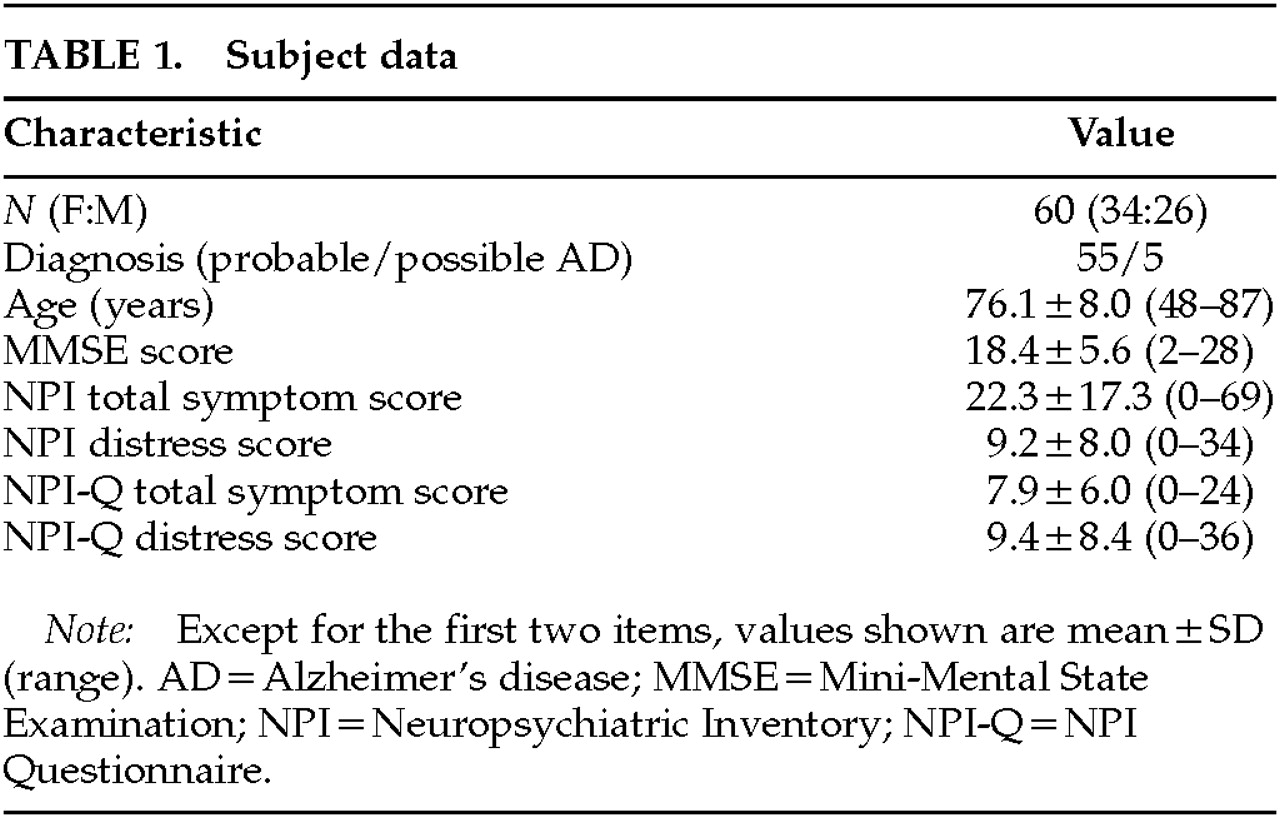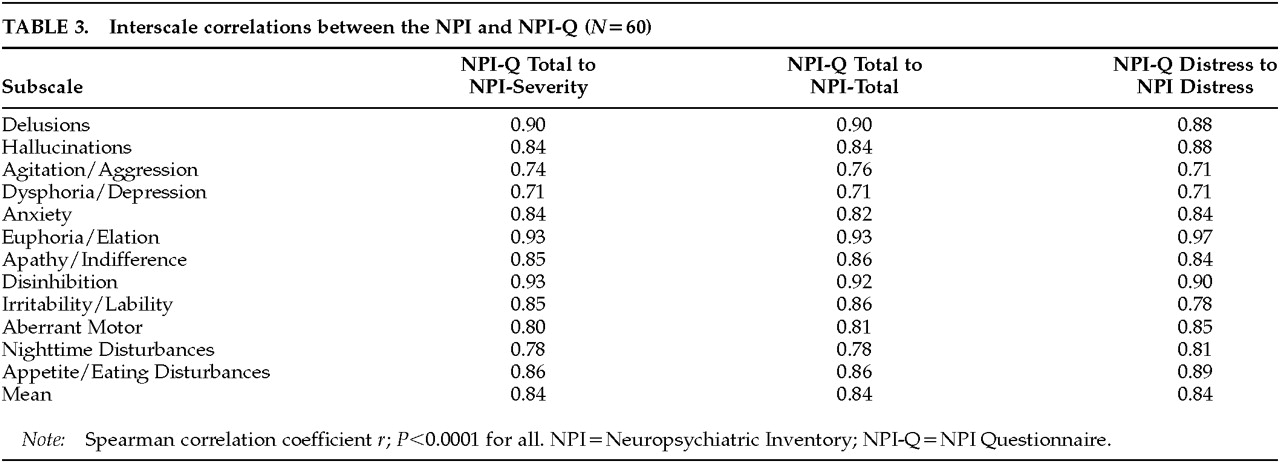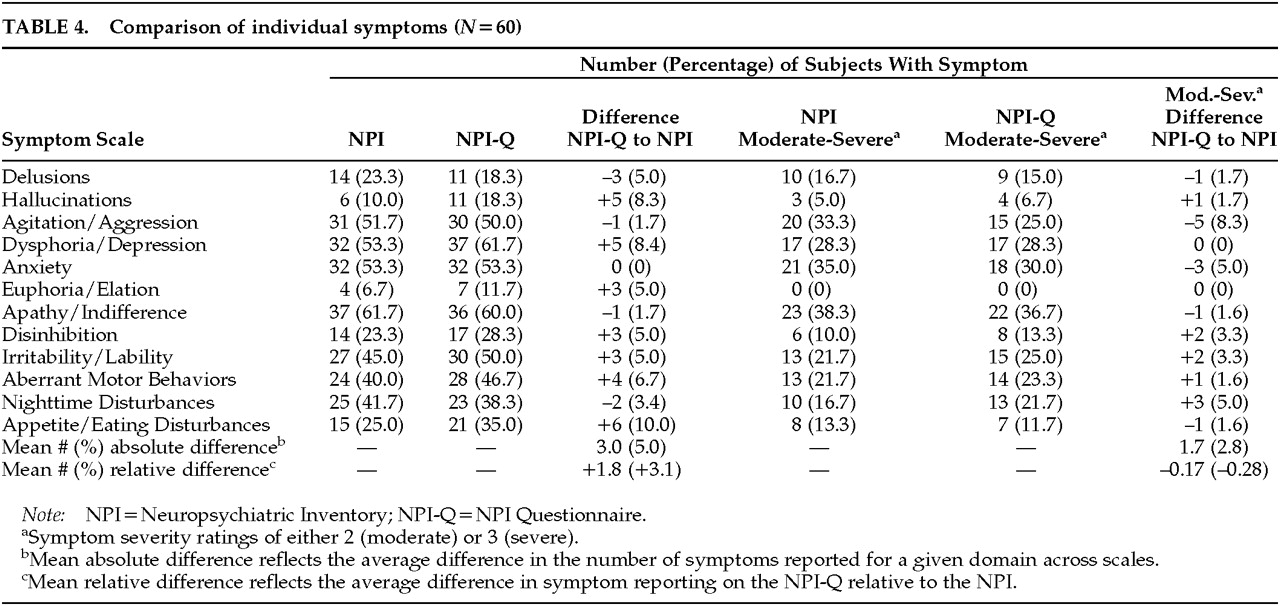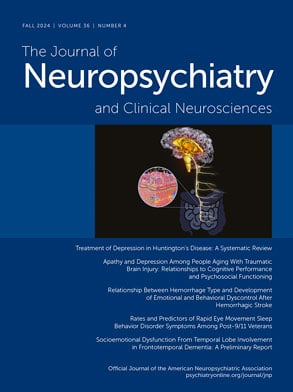Neuropsychiatric symptoms such as apathy, disinhibition, depression, psychosis, and agitation commonly accompany progressive cognitive and functional decline in Alzheimer's disease (AD).
1–6 Although behavior and personality disturbances are more variably manifest in AD than are cognitive deficits, there is increasing recognition that such noncognitive symptoms are pathophysiologically associated with the disease.
7–9 Neuropsychiatric symptoms may contribute significantly to the overall morbidity of AD on both patients and caregivers, underscoring the importance of identifying and quantifying patient symptoms and their impact on caregivers.
10–13 Moreover, in one study
14 a caregiver's ability to cope with problematic behaviors was more strongly associated with nursing home placement than was the degree of problematic behavior per se. Assessing neuropsychiatric symptoms in patients with dementia is thus critical to providing high-quality care in clinical practice. To facilitate this process, a brief, comprehensive, and reliable tool is needed.
A number of validated behavioral symptom rating scales have been developed for use in clinical research studies involving patients with AD.
5,15 Most of these scales rely on a caregiver-informant interview, as opposed to clinician rating or self-report, but differ in item content, retrospective observation period (1 week to 1 month), and symptom dimensions assessed (i.e., frequency or severity of behavioral disturbance). Although a structured or semistructured interview is the format most commonly used on these scales, the time required to complete the interview, typically 15 minutes or longer, makes their use in general practice settings impractical. In contrast, a brief cognitive screening assessment for dementia, the Mini-Mental State Examination (MMSE),
16 is widely used in both clinical and research settings. It would be advantageous to have a similar common means for assessing neuropsychiatric symptoms in research and practice.
The Neuropsychiatric Inventory (NPI) is a validated informant-based interview that is widely used in clinical research studies to evaluate neuropsychiatric symptoms and their response to treatment in dementia patients.
17 The NPI has been shown to have adequate test-retest and interrater reliability, as well as good concurrent validity with relevant items from the Behavioral Pathology in Alzheimer's Disease Rating Scale (Behave-AD)
18 and the Hamilton Rating Scale for Depression.
19 An adjunct scale for evaluating caregiver distress in relation to each symptom domain has recently been developed and validated.
12 The NPI has demonstrated stage-specific trends in neuropsychiatric symptoms in AD patients
6 and has been shown to be sensitive to cholinergic drug treatment effects in several clinical studies,
20,21 including one large prospective double-blind placebo-controlled trial.
22,23 The purposes of this study were to develop a brief version of the NPI that is suitable for use in general clinical practice settings, and to assess the psychometric properties of this instrument, the Neuropsychiatric Inventory Questionnaire (NPI-Q), in relation to the standard NPI.
METHODS
The NPI is a retrospective (to 1 month) caregiver-informant interview covering 12 neuropsychiatric symptom domains: delusions, hallucinations, agitation/aggression, dysphoria/depression, anxiety, euphoria/elation, apathy/indifference, disinhibition, irritability/lability, aberrant motor behaviors, nighttime behavioral disturbances, and appetite/eating disturbances. The scripted NPI interview includes a compound screening question for each symptom domain, followed by a list of interrogatives about domain-specific behaviors that is administered when a positive response to a screening question is elicited. Neuropsychiatric manifestations within a domain are collectively rated by the caregiver in terms of both frequency (1 to 4) and severity (1 to 3), yielding a composite symptom domain score (frequency×severity). Frequency and severity rating scales have defined anchor points to enhance the reliability of caregiver responses. Caregiver distress is rated for each positive neuropsychiatric symptom domain on a scale anchored by scores of 0 (not distressing at all) and 5 (extremely distressing).
The NPI-Q differs from the standard NPI in several ways. It is given as a two-page self-administered questionnaire, as opposed to an interview. Written instructions for completing the questionnaire form are included, as are anchor points for symptom severity and caregiver distress ratings. Each of the 12 symptom domains is assessed by a written screening question derived from the NPI that covers core symptom manifestations. The wording of screening questions used in the NPI-Q (e.g., Apathy: Does he/she seem less interested in his/her usual activities or in the activities of others?) is taken directly from the NPI screening questions, although in some cases the compound screening questions were shortened. Informants are asked to circle “yes” or “no” in response to each screening question, and to either proceed to the next question if the answer is “no” or to rate the symptoms present in the last 4 weeks if the answer is “yes.” Neuropsychiatric symptoms are assessed in terms of severity on the same three-point scale as the NPI (1-mild, 2-moderate, 3-severe), using similar anchor points. The rationale for assessing only symptom severity on the NPI-Q is the finding that symptom severity is more strongly correlated with caregiver distress (i.e., more clinically significant) than how often the symptom occurs.
12 Moreover, severity and frequency ratings are highly correlated on the NPI.
17 The total NPI-Q severity score represents the sum of individual symptom scores and ranges from 0 to 36. Caregiver distress associated with the symptom is rated on an anchored 0- to 5-point scale identical to that used in the NPI.
12 The total NPI-Q distress score represents the sum of individual symptom scores and ranges from 0 to 60. Informants typically complete the NPI-Q in 5 minutes or less.
All subjects participating in the study provided informed consent in conjunction with their caregiver-informants as part of their evaluation in the University of Pittsburgh Alzheimer's Disease Research Center Memory Disorders or Treatment Clinics.
24 The standard NPI and NPI-Q were administered to the informants of 60 consecutive AD (55 probable, 5 possible) subjects.
25 In all cases the NPI-Q was completed by the caregiver-informant before the NPI, to avoid having informant responses to the questionnaire biased by the NPI interview. The clinician conducting the NPI interview was blinded to the results of the NPI-Q, which was reviewed for completeness and queries by another clinician.
The 60 caregiver-informants included 31 women and 29 men. Of these, 43 were spouses, 14 were sons or daughters, and 1 each was a grandson, friend, or sister. All spouse caregivers and the grandson informant lived with the patient; the sons, daughters, sister, and friend who were primary informants did not live with the patient.
Test-retest reliability was assessed in 15 informants (25% of the sample) by asking them to complete a blank NPI-Q form upon arriving home that same day and to mail it back to the clinic. Because the purpose of the test-retest administrations was to examine how consistent informant responses were for the same assessment period (the previous 4 weeks), a relatively short interval of several hours between administrations was used.
Pearson correlational analyses were used to examine test-retest reliability between total NPI-Q scores on the two administrations and convergent validity between NPI-Q and NPI subscale scores summed across all symptom domains. The latter analysis of the summed scores was repeated after stratifying subjects by MMSE score to examine the effect of dementia severity on the degree of correlation between the NPI and NPI-Q.
Corresponding individual symptom subscale scores on the NPI and NPI-Q were examined with more conservative nonparametric Spearman correlation coefficients because of the nonlinear distribution of composite NPI symptom scores (frequency×severity). Discrepancies in individual symptom prevalence across scales were assessed in terms of both the absolute and the relative difference, the latter taking into account the direction as well as the magnitude of disparity. To focus on more clinically significant symptom manifestations, we then repeated this analysis of subscale scores for symptoms reported on either scale to be either moderate or severe.
RESULTS
The study population represents a broad cross-section of dementia severity among community-dwelling AD patients, with MMSE scores ranging from 2 to 28 (
Table 1). Mean ratings of neuropsychiatric symptom severity and caregiver distress, and the range of responses on these measures across both scales, were similar for the NPI and NPI-Q. All patients had at least one neuropsychiatric symptom reported to be present on both the NPI and the NPI-Q.
Test-retest correlations between the total symptom and distress scores on the NPI-Q in 15 subjects were 0.80 and 0.94, respectively (P<0.0001 for both; mean interval 6.9 hours).
Interscale correlation between the NPI total score (sum of frequency×severity ratings for all domains) and the NPI-Q severity total was 0.91; interscale correlation between caregiver distress ratings was 0.92 (
Table 2). When subjects were stratified by MMSE score into High (MMSE>18,
n=29) and Low (MMSE≤18,
n=31) groups, the correlation between total NPI and NPI-Q scores was 0.90 for High and 0.95 for Low MMSE. Overall, NPI and NPI-Q total scores were significantly correlated (inversely) with MMSE score. When the subjects were stratified by MMSE levels, a significant association between both of the neuropsychiatric measures and the MMSE score was observed in the Low MMSE group only.
Interscale item correlations for both patient symptom ratings (range 0.71–0.93) and caregiver distress ratings (range 0.71–0.97) were strongest for euphoria, disinhibition, and delusions, and weakest for agitation and depression (
Table 3). All item and total scale correlations were highly significant (
P<0.0001). Interscale item correlations between the NPI-Q symptom total (severity) rating and either the NPI total or the NPI severity ratings were virtually identical.
Fifty percent or more of all subjects were reported on both scales to have symptoms of apathy, dysphoria, anxiety, and agitation. Less than 20% had symptoms of hallucinations or euphoria (
Table 4). More patient symptoms were reported on the NPI-Q (283) compared with the NPI (257). Seven symptom domains were reported as 5% to 10% more prevalent on the NPI-Q than on the NPI, including appetite/eating disturbances, dysphoria, hallucinations, aberrant motor behaviors, euphoria, disinhibition, and irritability. Delusions, nighttime disturbances, apathy, and agitation were not reported as often on the NPI-Q as on the NPI; the prevalence of these symptoms differed by 5% or less across the two scales. Anxiety symptoms were equally prevalent on the NPI and NPI-Q. Overall, the average difference between the two scales for reporting a given symptom was 5% (mean absolute difference). The mean relative difference, reflecting the net difference in reported symptom prevalence, was 3.1%, with a higher mean for the NPI-Q than for the NPI. That is, an individual symptom was reported, on average, to be 3.1% more prevalent on the NPI-Q than on the NPI.
For symptoms rated to be moderate or severe in intensity, slightly more were reported on the NPI (144) than on the NPI-Q (142). Moderate to severe nighttime disturbances, irritability, disinhibition, and hallucinations were reported to be more prevalent on the NPI-Q, whereas moderate to severe anxiety, apathy, appetite/eating disturbances, and delusions were more commonly reported on the NPI. None of these differences in reported prevalence exceeded 5%. Reported moderate to severe symptoms of euphoria and dysphoria were equally prevalent across the scales. Only moderate to severe agitation differed by more than 5% between the scales (8.3% more prevalent on the NPI). The mean absolute difference between the NPI and NPI-Q in reporting moderate to severe symptoms in a given domain was 2.8%. The mean relative difference for moderate to severe symptoms in analogous domains across scales was 0.28%, with lower prevalence on the NPI-Q than on the NPI.
DISCUSSION
The purpose of this study was to examine the psychometric properties of a brief questionnaire form of the NPI designed for use in everyday clinical practice settings. A primary aim of the NPI-Q is to facilitate the assessment of neuropsychiatric disturbances as part of a routine clinical dementia evaluation. In this context, the NPI-Q provides a brief screening tool to identify clinically significant neuropsychiatric disturbances and their associated impact on caregivers. The NPI-Q has also been shown to be sensitive to cholinergic therapy-related changes in an open-label study,
24 and may thus facilitate efforts to assess the efficacy and caregiver impact of clinical therapeutic interventions for neuropsychiatric disturbances in patients with AD and other dementias.
The NPI-Q showed adequate test-retest reliability and convergent validity with respect to total and individual symptom domain scores and caregiver distress ratings on the NPI. The NPI-Q symptom severity scale was highly correlated with both the composite frequency×severity score from the NPI and the analogous NPI severity score. The degree to which NPI and NPI-Q total symptom scores were correlated was greater in subjects with more severe dementia (Low MMSE group compared with High MMSE group) but was still robust in the group with less severe dementia. Both NPI and NPI-Q total scores were significantly correlated to MMSE score in the Low MMSE group (r=0.44 for both), whereas no association between MMSE score and NPI or NPI-Q ratings of neuropsychiatric symptoms was observed in the High MMSE group. These findings suggest that neuropsychiatric symptom manifestations in community-dwelling AD patients may become a more consistent feature of the disease as it progresses over time. Alternatively, informants may become more attuned to observing and reporting neuropsychiatric symptoms as they gain more experience in the caregiver role.
Neuropsychiatric symptom prevalence as assessed by the two scales differed by 5% overall, and it tended to be higher on the NPI-Q. This finding is consistent with the approximately 5% false-positive rate observed on NPI screening questions.
17 However, interscale differences were less than 2% for symptoms that were moderate to severe in intensity, suggesting that the two scales are similar in capturing clinically significant neuropsychiatric manifestations. The NPI-Q-rated symptom prevalence was ≥5% higher compared with the NPI on four domains (hallucinations, dysphoria, aberrant motor behaviors, and appetite/eating disturbances). However, moderate to severe symptom ratings in all four differed by less than 2%.
Overall, hallucinations were much more likely to be reported on the NPI-Q and delusions were more commonly reported on the NPI. In contrast, moderate to severe ratings of these symptoms showed good agreement across the two scales. This disparity suggests that informants may have difficulty distinguishing mild manifestations of hallucinations and delusions on the NPI-Q, but they appear to be more consistent in their reporting when the symptom manifestations are of greater intensity. Dysphoria symptom ratings showed a similar pattern, with higher prevalence of all reported symptoms on the NPI-Q but with equal prevalence between the two scales for moderate to severe symptom manifestations. Dysphoria ratings also showed the lowest overall degree of correlation for any symptom domain between the two scales (
r=0.71). Together, these findings may be explained by the observation that the dysphoria screening question on the NPI elicited the highest false-positive response rate of any symptom.
17 As with dysphoria, agitation/aggression symptom ratings showed a relatively lower, although highly significant, overall correlation between the NPI and NPI-Q (
r=0.76) but showed a converse relationship in severity-adjusted symptom prevalence between the two scales. That is, overall ratings of agitation/aggression symptoms showed good concurrence, but the reported prevalence of moderate to severe agitation/aggression symptoms was 8.3% higher on the NPI compared with the NPI-Q. These data suggest that the NPI-Q is sensitive to symptoms of agitation/aggression measured by the NPI but may underestimate their severity. As one of the broadest NPI symptom domains, agitation/aggression symptoms may have tended to have higher severity ratings on the NPI due to the cumulative effect of multiple symptom manifestations being identified as present.
Minor discrepancies observed between ratings on the NPI and NPI-Q for the above symptom domains (delusions, hallucinations, depression/dysphoria, and agitation/aggression) may also be attributable in part to the abbreviated wording used on the NPI-Q. Including more of the NPI screening question content on the corresponding NPI-Q items would be expected to enhance interscale congruence.
An important feature of the NPI-Q, as with the NPI, is the provision for caregiver ratings of distress related to each distinct symptom manifestation.
12 Although overall symptom severity and caregiver distress ratings are strongly correlated, how distressing a particular symptom manifestation is to an individual caregiver is much more variable.
12 High caregiver distress ratings in relation to a specific neuropsychiatric symptom may help determine the need for directed interventions involving the patient, the caregiver, or both.
This study was conducted in a university-based research clinic on a generally highly educated Caucasian subject and informant population. Although it is not clear how these findings may generalize to diverse community practice settings, the format and wording of the NPI-Q were designed to make it straightforward and widely applicable. It is possible that less educated informants may have difficulty completing the form or understanding the questions. In such cases, the NPI-Q might be administered as an abbreviated interview or as a combination questionnaire-interview. Further study of the NPI-Q in clinical practice settings involving more ethnically and demographically diverse subject populations is necessary.
ACKNOWLEDGMENTS
The study was supported by National Institute on Aging Alzheimer Disease Center Grants AG10123 and AG10533. D.K. was supported by a Merck-AFAR Clinical Geriatric Pharmacology Fellowship and the Augustus Rose Fellowship of the John Douglas French Alzheimer's Foundation. A portion of this work was presented at the Tenth Annual Meeting of the American Neuropsychiatric Association, New Orleans, LA, February 1999.
The NPI and NPI-Q are copyright-protected (Jeffrey L. Cummings, M.D.). All rights reserved.





